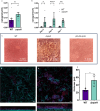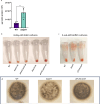M.marinum lacking epsH shows increased biofilm formation in vitro and boosted antibiotic tolerance in zebrafish
- PMID: 40517184
- PMCID: PMC12167362
- DOI: 10.1038/s41522-025-00743-5
M.marinum lacking epsH shows increased biofilm formation in vitro and boosted antibiotic tolerance in zebrafish
Abstract
Recent discoveries have indicated that biofilm communities may play a role in natural drug tolerance of Mycobacterium tuberculosis. A transposon-based mutation library of a closely related species, Mycobacterium marinum, was used to identify clones in which the relative amount of extracellular DNA (eDNA), an important component of the extracellular matrix of biofilms, is altered. The disruption of a putative glycosyl transferase gene QDR78 11175, epsH, caused a substantial increase of the eDNA content of biofilms, and increased the growth rate and the biomass/cell in biofilm-forming conditions compared to wild-type. The increased abundance of biomass was mainly due to the elevated levels of eDNA and proteins in the extracellular matrix. The growth of the ΔepsH strain in the zebrafish was normal, but the mutant developed greater antibiotic tolerance in the adult zebrafish model. These results suggest that the extracellular matrix of biofilms increases antibiotic tolerance of mycobacteria during infection.
© 2025. The Author(s).
Conflict of interest statement
Competing interests: The authors declare no competing interests.
Figures









References
-
- Global tuberculosis report 2024. Geneva: World Health Organization; 2024. Licence: CC BY-NC-SA 3.0 IGO.
-
- WHO Consolidated Guidelines on Tuberculosis. Module 4: Treatment - Drug-Susceptible Tuberculosis Treatment. (World Health Organization, Geneva, 2022). - PubMed
-
- Flemming, H.-C. et al. Biofilms: an emergent form of bacterial life. Nat. Rev. Microbiol.14, 563–575 (2016). - PubMed
MeSH terms
Substances
Grants and funding
LinkOut - more resources
Full Text Sources
Medical

